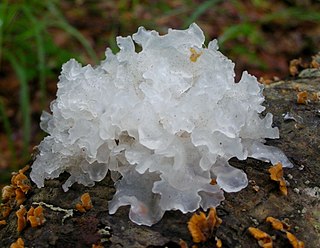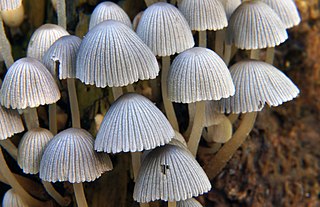
Jelly fungi are a paraphyletic group of several heterobasidiomycete fungal orders from different classes of the subphylum Agaricomycotina: Tremellales, Dacrymycetales, Auriculariales and Sebacinales. These fungi are so named because their foliose, irregularly branched fruiting body is, or appears to be, the consistency of jelly. Actually, many are somewhat rubbery and gelatinous. When dried, jelly fungi become hard and shriveled; when exposed to water, they return to their original form.

Tremella fuciformis is a species of fungus; it produces white, frond-like, gelatinous basidiocarps. It is widespread, especially in the tropics, where it can be found on the dead branches of broadleaf trees. This fungus is commercially cultivated and is one of the most popular fungi in the cuisine and medicine of China. T. fuciformis is commonly known as snow fungus, snow ear, silver ear fungus, white jelly mushroom, and white cloud ears.

Wood-ear or tree ear, also translated wood jellyfish or tree jellyfish, can refer to a few similar-looking edible fungi used primarily in Chinese cuisine; these are commonly sold in Asian markets shredded and dried.

Tremella mesenterica is a common jelly fungus in the family Tremellaceae of the Agaricomycotina. The gelatinous, orange-yellow fruit body of the fungus, which can grow up to 7.5 cm (3 in) diameter, has a convoluted or lobed surface that is greasy or slimy when damp.

Hypoxylon is a genus of ascomycetes commonly found on dead wood, and usually one of the earliest species to colonise dead wood. A common European species is Hypoxylon fragiforme which is particular common on dead trunks of beech.

Agaricomycotina is one of three subdivisions of the Basidiomycota, and represents all of the fungi which form macroscopic fruiting bodies. Agaricomycotina contains over 30,000 species, divided into three classes: Tremellomycetes, Dacrymycetes, and Agaricomycetes. Around 98% of the species are in the class Agaricomycetes, including all the agarics, bracket fungi, clavarioid fungi, corticioid fungi, and gasteroid fungi. Tremellomycetes contains many basidiomycete yeasts and some conspicuous jelly fungi. Dacrymycetes contains a further group of jelly fungi. These taxa are founded on molecular research, based on cladistic analysis of DNA sequences, and supersede earlier morphology-based classifications. Agaricomycotina contains nearly one third of all described species of fungi.

Tremella is a genus of fungi in the family Tremellaceae. All Tremella species are parasites of other fungi and most produce anamorphic yeast states. Basidiocarps, when produced, are gelatinous and are colloquially classed among the "jelly fungi". Over 100 species of Tremella are currently recognized worldwide. One species, Tremella fuciformis, is commercially cultivated for food.

Annulohypoxylon, sometimes called cramp balls, is a genus of fungi in the family Xylariaceae. The 27 species in the genus have a collectively widespread distribution.
Annulohypoxylon archeri is a saprophytic fungus species. It was moved from the genus Hypoxylon into the genus Annulohypoxylon erected in 2005 by Hsieh, Ju and Rogers.
Streptomyces deccanensis is an alkaliphilic bacterium species from the genus of Streptomyces which has been isolated from soil in the city Gulbarga in the Karnataka in India.
Streptomyces jiujiangensis is a bacterium species from the genus of Streptomyces which has been isolated from rhizosphere soil from a pine tree from the Mount Lu in the Jiangxi province in China. Streptomyces jiujiangensis produces antialgal compounds.
Streptomyces lacticiproducens is a bacterium species from the genus of Streptomyces which has been isolated from the rhizosphere of a tomato plant in Guangzhou in China. Streptomyces lacticiproducens produces lactic acid.
Streptomyces qinglanensis is a bacterium species from the genus of Streptomyces which has been isolated from mangrove soil from Wenchang in the Hainan in China.
Streptomyces rosealbus is a bacterium species from the genus of Streptomyces which has been isolated from forest soil from Yongsheng from the Yunnan Province in China.
Streptomyces xishensis is a bacterium species from the genus of Streptomyces which has been isolated from marine sediments from the South China Sea near the Xisha Islands in China.
Streptomyces tibetensis is a bacterium species from the genus of Streptomyces which has been isolated from soil from the Tibetan Plateau in China.
Streptomyces apocyni is a bacterium species from the genus Streptomyces which has been isolated from the plant Apocynum venetum from Xinjiang in China.

Naematelia aurantia is a species of fungus producing yellow, frondose, gelatinous basidiocarps. It is widespread in north temperate regions and is parasitic on another species of fungus that grows on dead attached and recently fallen branches of broadleaf trees. It is commonly called golden ear in North America.
Tremella olens is a species of fungus in the family Tremellaceae. It produces soft, whitish, lobed to frondose, gelatinous basidiocarps and is parasitic on other fungi on dead branches of broad-leaved trees. It was originally described from Tasmania.
Tremella yokohamensis is a species of fungus in the family Tremellaceae. It produces white, foliaceous, gelatinous basidiocarps and is parasitic on other fungi on dead wood of broad-leaved trees. It was originally described from Japan.








